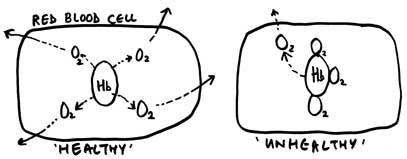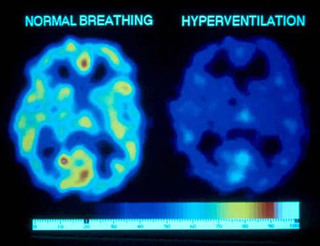Buteyko Breathing Method theory (named after the Russian physician and researcher, Professor K P Buteyko) is based on the understanding that over-breathing disturbs the balance of oxygen and carbon dioxide in our lungs. At the end of the 19th Century, carbon dioxide was found to be responsible for the bond between oxygen and haemoglobin. If the levels of carbon dioxide in the blood are lower than normal, this leads to difficulties in releasing oxygen from haemoglobin. This is known as the Bohr Effect.

In cases of severe hyperventilation and CO2 loss (hypocapnia) up to 80% of the oxygen contained in red blood cells is returned to the lungs undelivered. This can result in a significant reduction in the oxygen supply to the brain and body tissues, a condition known as cellular hypoxia.
Loss of carbon dioxide during hyperventilation causes smooth muscle to constrict around airways and blood vessels, reducing the availability of oxygen to the brain and body tissues. Professor Buteyko maintains that this is what causes chest tightness in asthma and is the main factor in blocked noses. An asthma attack is the body’s way of attempting to reduce the airflow passing through the lungs in order to reduce carbon dioxide loss.
'Deep breathing disease'
According to Professor Buteyko, 200 different chronic diseases are essentially just one, which he called “deep breathing disease”. When breathing is normalised which can be done simply by decreasing its depth thus allowing carbon dioxide in alveolar air to reach the desired level of 6.5%, symptoms can disappear.
Though most people may think of it as a poison, carbon dioxide may, in fact, be the “breath of life”.
The chemistry of respiration
‘I now understand that the stress of daily life promotes deep breathing - a bad habit fortified by the widely prevailing notion that moving a lot of oxygen into our lungs is a good thing.’
Robert Picciotto,
Professor, King's College London |
Breathing disorders such as asthma, sinusitis and hay fever are the result of hyperventilation/ over-breathing. When we over- breathe we disturb the balance of oxygen and carbon dioxide in our lungs and blood vessels.
To understand the hazards of over-breathing (hyperventilation) it is necessary to cover some basic principles of respiration and the important role of carbon dioxide in health.
Respiration serves to deliver oxygen to the tissues where it is needed and to remove excess carbon dioxide via the lungs. Oxygen is transported within red blood cells in the blood as oxy-haemoglobin. Each haemoglobin blood protein can carry up to four oxygen molecules. Oxygenated blood is circulated with great precision to those parts of the body where it is most required.
By ingenious design the cells most needy of oxygen are those that produce the most carbon dioxide, carbon dioxide being a by-product of cellular metabolism. Carbon dioxide diffuses across the cell membrane into the blood vessels. The increase in carbon dioxide saturation of the blood acts as a vasodilator (relaxing the smooth muscle in the blood vessels) ensuring the free flow of oxygenated blood to the oxygen-hungry tissues. In addition to this, elevated carbon dioxide levels in the blood facilitate the release of oxygen from haemoglobin; this is known as the Bohr Effect.
The hazards of hyperventilation
Anyone who has experienced dizziness after blowing up party balloons or an air mattress will be familiar with the effect that breathing too much air has on reducing oxygen supply to the brain. If breathing large volumes of air is supposed to be beneficial, why does it make us dizzy?
Hyperventilation, or over-breathing, does not add oxygen to arterial blood. Under normal breathing the blood is close to saturation with respect to oxygen and is simply not able to absorb more. However, over-breathing depletes carbon dioxide in airways and arterial blood producing a condition known as hypocapnia. Hypocapnia reduces oxygen availability to our cells in two ways:
- As blood levels of carbon dioxide drop during hyperventilation, smooth muscle constricts around the blood vessels restricting the flow of oxygenated blood to the tissues.
- Lower levels of carbon dioxide dissolved in the blood shift blood pH towards a state known as respiratory alkalosis and the haemoglobin which transports oxygen in the blood binds more tightly with the oxygen reducing its release to the body tissues.
Over-breathing and cerebral hypoxia
The figure below shows how even a few minutes of over-breathing (hyperventilation) can starve your brain of oxygen. If one minute of hyperventilation can do this, imagine the toxic effect on your body from a lifetime of over-breathing.

Functional MRI scan of a human brain showing oxygen saturation of haemoglobin.
Red and yellow areas correspond to highest oxygen saturation of haemoglobin
The left-hand image shows normal oxygen saturation in a healthy breather's brain. The right-hand image shows oxygen availability in the brain is reduced by 40% as a result of about a minute of over-breathing (hyperventilation). Not only is oxygen availability reduced, but glucose critical to brain functioning is also markedly reduced as a result of cerebral vasoconstriction (Litchfield 2003)1.
Over-breathing and its effects on health
Over-breathing can trigger asthma attacks, panic attacks, migraines and exacerbate a range of disorders including: breathlessness, shortness of breath, asthma, hypertension, heart palpitations, irregular heart beat, dizziness, spacey feelings, tingling in hands and feet, numbness, light headedness, fatigue, sleep apnoea, cold hands and feet, digestive disorders including gastric reflux, bloatedness, irritable bowel and stress disorders.
Professor Konstantin Buteyko attributed over 200 disease states to dysfunctional breathing. The Method he developed is a strategy to retrain dysfunctional breathing with simple breathing exercises and lifestyle guidelines that achieve freedom from symptoms and restore health by normalising breathing.
The Buteyko Breathing Method has helped thousands of people throughout the world to overcome their sleep apnea, asthma and other breathing conditions.
Read testimonials from Buteyko Breathing Clinics' clients and clinicians »
1 Litchfield P.M. A brief history of the chemistry of respiration and the breathing heart wave. California Biofeedback.Vol 19 No.1 (Spring 2003)